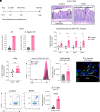Murine gut microbiota dysbiosis via enteric infection modulates the foreign body response to a distal biomaterial implant
- PMID: 40354538
- PMCID: PMC12107164
- DOI: 10.1073/pnas.2422169122
Murine gut microbiota dysbiosis via enteric infection modulates the foreign body response to a distal biomaterial implant
Abstract
The gut microbiota influences systemic immunity and the function of distal tissues, including the brain, liver, skin, lung, and muscle. However, the role of the gut microbiota in the foreign body response and fibrosis is largely unexplored. To investigate this connection, we perturbed the homeostasis of the murine gut microbiota via infection with the pathogenic bacterial species enterotoxigenic Bacteroides fragilis (ETBF) and implanted particulate material (mean particle size <600 μm) of the synthetic polymer polycaprolactone (PCL) into a distal muscle injury. ETBF infection in mice led to increased neutrophil and γδ T cell infiltration into the PCL implant site. ETBF infection alone promoted systemic inflammation, increased levels of neutrophils in lymphoid tissues, and altered skeletal muscle gene expression. At the PCL implant site, we found significant changes in the transcriptome of sorted stromal cells between infected and control mice, including differences related to ECM components such as proteoglycans and glycosaminoglycans. However, we did not observe ETBF-induced differences in fibrosis levels. These results demonstrate the ability of the gut microbiota to mediate long-distance effects such as immune and stromal responses to a distal biomaterial implant.
Keywords: biomaterials; foreign body response; gut microbiota; immune response; infection.
Conflict of interest statement
Competing interests statement:J.H.E. is a consultant for Tessara. D.M.P. is a consultant at Aduro Biotech, Amgen, Astra Zeneca, Bayer, Compugen, DNAtrix, Dynavax Technologies Corporation, Ervaxx, FLX Bio, Immunomic, Janssen, Merck, and Rock Springs Capital. D.M.P. is a member of the scientific advisory board for Bristol Myers Squibb, Camden Nexus II, Five Prime Therapeutics, and WindMil. D.M.P. is a member of board of directors in Dracen Pharmaceuticals. J.H.E. holds equity in Unity Biotechnology and Aegeria Soft Tissue. D.M.P. holds equity in Aduro Biotech, DNAtrix, Ervaxx, Five Prime therapeutics, Immunomic, Potenza, Trieza Therapeutics.
Figures



Update of
-
Murine gut microbiota dysbiosis via enteric infection modulates the foreign body response to a distal biomaterial implant.bioRxiv [Preprint]. 2025 Jan 17:2025.01.13.632473. doi: 10.1101/2025.01.13.632473. bioRxiv. 2025. Update in: Proc Natl Acad Sci U S A. 2025 May 20;122(20):e2422169122. doi: 10.1073/pnas.2422169122. PMID: 39868312 Free PMC article. Updated. Preprint.
References
-
- Dolan E. B., et al. , An actuatable soft reservoir modulates host foreign body response. Sci. Robot. 4, 7043 (2019). - PubMed
-
- Zhang D., et al. , Dealing with the foreign-body response to implanted biomaterials: Strategies and applications of new materials. Adv. Funct. Mater. 31, 2007226 (2021).
-
- Yang B., Rutkowski N., Elisseeff J., The foreign body response: Emerging cell types and considerations for targeted therapeutics. Biomater. Sci. 11, 7730–7747 (2023). - PubMed
MeSH terms
Substances
Grants and funding
LinkOut - more resources
Full Text Sources

